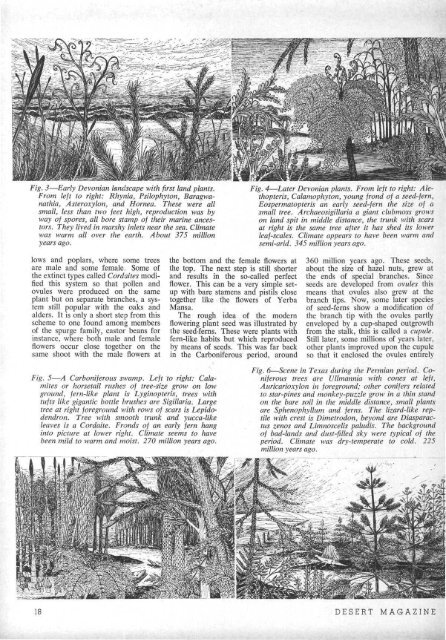desert calendar - Desert Magazine of the Southwest
desert calendar - Desert Magazine of the Southwest
desert calendar - Desert Magazine of the Southwest
Create successful ePaper yourself
Turn your PDF publications into a flip-book with our unique Google optimized e-Paper software.
Fig. 3—Early Devonian landscape with first land plants.<br />
From left to right: Rhynia, Psilophyton, Baragwanathia,<br />
Asteroxylon, and Hornea. These were all<br />
small, less than two feet high, reproduction was by<br />
way <strong>of</strong> spores, all bore stamp <strong>of</strong> <strong>the</strong>ir marine ancestors.<br />
They lived in marshy inlets near <strong>the</strong> sea. Climate<br />
was warm all over <strong>the</strong> earth. About 375 million<br />
years ago.<br />
lows and poplars, where some trees<br />
are male and some female. Some <strong>of</strong><br />
<strong>the</strong> extinct types called Cordaites modified<br />
this system so that pollen and<br />
ovules were produced on <strong>the</strong> same<br />
plant but on separate branches, a system<br />
still popular with <strong>the</strong> oaks and<br />
alders. It is only a short step from this<br />
scheme to one found among members<br />
<strong>of</strong> <strong>the</strong> spurge family, castor beans for<br />
instance, where both male and female<br />
flowers occur close toge<strong>the</strong>r on <strong>the</strong><br />
same shoot with <strong>the</strong> male flowers at<br />
Fig. 5—A Carboniferous swamp. Left to right: Calamites<br />
or horsetail rushes <strong>of</strong> tree-size grow on low<br />
ground, fern-like plant is Lyginopteris, trees with<br />
tufts like gigantic bottle brushes are Sigillaria. Large<br />
tree at right foreground with rows <strong>of</strong> scars is Lepidodendron.<br />
Tree with smooth trunk and yucca-like<br />
leaves is a Cordaite. Fronds <strong>of</strong> an early fern hang<br />
into picture at lower right. Climate seems to have<br />
been mild to warm and moist. 270 million years ago.<br />
<strong>the</strong> bottom and <strong>the</strong> female flowers at<br />
<strong>the</strong> top. The next step is still shorter<br />
and results in <strong>the</strong> so-called perfect<br />
flower. This can be a very simple setup<br />
with bare stamens and pistils close<br />
toge<strong>the</strong>r like <strong>the</strong> flowers <strong>of</strong> Yerba<br />
Mansa.<br />
The rough idea <strong>of</strong> <strong>the</strong> modern<br />
flowering plant seed was illustrated by<br />
<strong>the</strong> seed-ferns. These were plants with<br />
fern-like habits but which reproduced<br />
by means <strong>of</strong> seeds. This was far back<br />
in <strong>the</strong> Carboniferous period, around<br />
Fig. 4—Later Devonian plants. From left to right: Alethopteris,<br />
Calamophyton, young frond <strong>of</strong> a seed-fern,<br />
Eospermatopteris an early seed-fern <strong>the</strong> size <strong>of</strong> a<br />
small tree. Archaeosigillaria a giant clubmoss grows<br />
on land spit in middle distance, <strong>the</strong> trunk with scars<br />
at right is <strong>the</strong> same tree after it has shed its lower<br />
leaf-scales. Climate appears to have been warm and<br />
semi-arid. 345 million years ago.<br />
360 million years ago. These seeds,<br />
about <strong>the</strong> size <strong>of</strong> hazel nuts, grew at<br />
<strong>the</strong> ends <strong>of</strong> special branches. Since<br />
seeds are developed from ovules this<br />
means that ovules also grew at <strong>the</strong><br />
branch tips. Now, some later species<br />
<strong>of</strong> seed-ferns show a modification <strong>of</strong><br />
<strong>the</strong> branch tip with <strong>the</strong> ovules partly<br />
enveloped by a cup-shaped outgrowth<br />
from <strong>the</strong> stalk, this is called a cupule.<br />
Still later, some millions <strong>of</strong> years later,<br />
o<strong>the</strong>r plants improved upon <strong>the</strong> cupule<br />
so that it enclosed <strong>the</strong> ovules entirely<br />
Fig. 6—Scene in Texas during <strong>the</strong> Permian period. Coniferous<br />
trees are Ullmannia with cones at left,<br />
Auricarioxylon in foreground; o<strong>the</strong>r conifers related<br />
to star-pines and monkey-puzzle grow in a thin stand<br />
on <strong>the</strong> bare soil in <strong>the</strong> middle distance, small plants<br />
are Sphenophyllum and ferns. The lizard-like reptile<br />
with crest is Dimetrodon, beyond are Diasparactus<br />
zenos and Limnoscelis paludis. The background<br />
<strong>of</strong> bad-lands and dust-filled sky were typical <strong>of</strong> <strong>the</strong><br />
period. Climate was dry-temperate to cold. 225<br />
million years ago.<br />
18 DESERT MAGAZINE

















